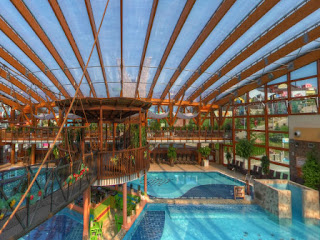 |
| Tatralandia in Liptovsky Mikulas |
I ran to the top of the stairs to see if he was still there but he was gone. I ran back downstairs pushing against the people walking up the stairs and finally saw him standing in the wadding pool on bottom.
Apparently, his mat got stuck and he had to scoot all the way down the slide. It took a while for my heart to calm down but the slides ended up being the best part of the day.
My family and I went to the largest year-round water park in Slovakia this last week, Tatralandia, and we had a great time (other than those couple of seconds of panic). I thought that my son would not get back on any slides after that. But we tried them all and he ended up wanting to slide all day.
He especially liked a slide called the "Tornado." You ride a two person raft and it shoots you out into a funnel and then slowly slings you around and around until you drop out the bottom. My legs hurt at the end of the day from climbing the stairs to ride the "Tornado" with him so much.
 |
| The Tornado Water Slide |
Tatralandia is located in Liptovsky Mikulas surrounded by the High Tatras (the largest mountain range in Slovakia). The pools are heated year-round and you can swim in the pools while there is snow just several feet from you. The snow was gone when we got there but you can still see the snow on the mountain tops surrounding the pools.
 |
| One of the outside pools with snow on the mountain tops |
My daughter is just learning how to swim and usually does not like water parks for too long. But she is gaining confidence with her swimming and stayed in the pools for almost eight hours straight! She is now diving under the water which is a big deal when last year she was scared to get her face wet.
 |
| My daughter loved the kid pool |
 |
| Starting to swim like a mermaid |
Tatralandia has 14 pools (10 that are open year-round) with salt water and thermal water. The water is supposed to have healing effects on your body and respiratory system. My wife loved the thermal hot spring water.
 |
| The warm indoor pools. Some had salt water. |
It is fun speaking very quick English to the kids as they just stare at you and get really quiet. Now, if only my own kids would get quiet when I talked to them in English!








